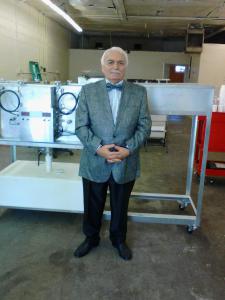Konstantin Balakiryan: Fuel cells "Delta-FC5". New generation
Currently, cost, performance, and durability remain key issues in the fuel cell industry, there are problems associated with overcoming critical technical barriers to efficient fuel cell development: 1. Cost - platinum group metals are used in fuel cell catalysts. 2. Performance - ion-exchange membranes are not effective enough for viable long term stationary and portable power source systems. 3. Durability - short life of the fuel cell system components.
It is these shortcomings with fuel cell design that impede their wider introduction into the country's energy sector, that the US Department of Energy has focused attention, and has requested leading US universities and laboratories to address these issues. We have been working with fuel cells since 2009 and, in our opinion, quite successfully solved a number of technical and technological problems associated with fuel cells.
It is known that in existing fuel cells, the oxygen used in the process is atmospheric air. At the moment, when thermal elements are not yet very common, this is acceptable. However, with massive industrial use of thermal elements, this can lead to an ecological disaster. Even today, the eco-system of the planet is experiencing difficulties due to the enormous consumption of atmospheric oxygen. It is no secret that, without exception, all energy generation devices using a combustion or explosion process (Carnot Cycle, Diesel, Thermal Power Plant, etc.) burn atmospheric oxygen.
The new generation design for fuel cells of the “Delta-FC5” series uses oxygen contained in water. We will first borrow water from the world's oceans, utilize its energy potential, and then the output water from the fuel cell will be returned to the source. It should be noted that the same volume of water, taking into account minor compensation of losses, can be used in these new generation fuel cells many times.
Thus, with a full transition to water-based fuel as the main source of energy on Earth, we eliminate the threat of environmental catastrophe associated with both the loss of atmospheric oxygen and the over expenditure of ocean water. The advantage of using oxygen extracted from water in fuel cells is clearly revealed when comparing the content per unit volume of oxygen in the atmosphere to that of water in the world's oceans. The proportion of oxygen (by mass) in water is 88.81%, while the proportion of oxygen in the air is only 20.93%.
Structurally, the “Delta-FC5” fuel cell is a kind of dual multi-electrode electron lamp divided by an impenetrable Teflon partition. Where a gas mixture containing 97% of hydrogen is supplied to the left compartment of the device, and a gas mixture containing 88% oxygen is fed to the right compartment.
For a more accurate description of the process of converting the chemical energy of hydrogen to electrical energy, we note that in a “Delta-FC5” fuel cell anions and cations are fed to the anode and cathode, not to hydrogen and oxygen. The ionization energy of the atoms of hydrogen and oxygen is about the same, in the range of 13.6 -14 Ev. Inside each compartment of the fuel cell “Delta-FC5”, special electrodes are mounted, to which electrical pulses are fed with a wide range of frequencies and amplitudes. This is due to the fact that the formation process of anions and cations at different stages is associated with overcoming the potential energy barriers for interaction, which exists inside atoms and their nuclei (A. Strong, B. Electromagnetic, .C.Weak, D.Gravitational).
Collective excitation of atoms using high-frequency electric pulses allows breaking bonds in the hydrogen atom, from which hydrogen loses an electron and becomes a charged hydrogen ion, and oxygen atoms capture electrons becoming negatively charged oxygen ions. Thus, in the fuel cell “Delta-FC5” eliminates the need for catalysts made from expensive and limited platinum group metals (PGM) Instead of short-lived, contaminated ion-conducting membranes such as the proton exchange membrane with a polymer electrolyte used in existing fuel cells, the “Delta-FC5” utilizes reliable and almost “eternal” control grids, separating the flows of positively and negatively charged ions.
With the new concept “Delta-FC5” fuel cells there are no design limitations on the power output or intended use. They can work perfectly both in stationary and portable conditions, providing heat and electricity for the city, industrial enterprises, and transport (road, rail, water, and air).
Therefore, the new “Delta-FC5” fuel cell concept opens up vast possibilities to the ubiquitous use of hydrogen as a versatile fuel supporting all types of energy necessary for our human needs moving forward.
Konstantin Balakiryan, PhD, Professor
k.balakiryan@gmail.com
Phone: 623 341 9623
Konstantin Balakiryan
BK Consulting
+1 623-341-9623
email us here
Legal Disclaimer:
EIN Presswire provides this news content "as is" without warranty of any kind. We do not accept any responsibility or liability for the accuracy, content, images, videos, licenses, completeness, legality, or reliability of the information contained in this article. If you have any complaints or copyright issues related to this article, kindly contact the author above.


